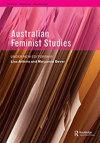Crazy Rich Asians: Towards an Ornamental Feminist Account of Wealth and Desire
IF 1.5
4区 社会学
Q2 WOMENS STUDIES
引用次数: 0
Abstract
Wealth is often seen as an object of desire. That is, it is what desire desires and it comes to represent desire. The accumulation of wealth is commonly considered excessive and coming at the cost of environmental and corporeal needs. Such an account of wealth follows an either/or logic that produces a set of oppositional terms such as nature or culture, desire or need, wealth or necessity, luxury or survival. This article explores questions of wealth and desire via the 2018 film Crazy Rich Asians. It uses the lens of ornament to zoom in on how the film depicts the relationship between the natural and the artificial, winning and losing, and subject and object. It proposes a feminist ornamental approach to wealth and desire that reworks the either/or logic and the oppositional terms that undergird it. It argues that this approach allows for an analysis of the relation between race, gender, nature, style, wealth and desire beyond one of commodification or recognition, ownership or dispossession.《疯狂的亚洲富人:对财富和欲望的装饰性女权主义描述》
财富常常被看作是欲望的对象。也就是说,它是欲望所渴望的,它代表欲望。财富的积累通常被认为是过度的,是以环境和物质需求为代价的。这种对财富的描述遵循非此即彼的逻辑,产生了一系列对立的术语,如自然或文化、欲望或需要、财富或必需品、奢侈或生存。本文通过2018年的电影《摘金奇缘》探讨了财富和欲望的问题。用点缀的镜头,放大影片如何描绘自然与人工、胜利与失败、主体与客体的关系。它提出了一种女权主义的财富和欲望观赏方法,重新设计了非此即彼的逻辑和支撑它的对立术语。它认为,这种方法允许对种族,性别,自然,风格,财富和欲望之间的关系进行分析,而不是商品化或认可,所有权或剥夺。
本文章由计算机程序翻译,如有差异,请以英文原文为准。
求助全文
约1分钟内获得全文
求助全文
来源期刊

Australian Feminist Studies
WOMENS STUDIES-
CiteScore
2.50
自引率
0.00%
发文量
7
期刊介绍:
Australian Feminist Studies was launched in the summer of 1985 by the Research Centre for Women"s Studies at the University of Adelaide. During the subsequent two decades it has become a leading journal of feminist studies. As an international, peer-reviewed journal, Australian Feminist Studies is proud to sustain a clear political commitment to feminist teaching, research and scholarship. The journal publishes articles of the highest calibre from all around the world, that contribute to current developments and issues across a spectrum of feminisms.
 求助内容:
求助内容: 应助结果提醒方式:
应助结果提醒方式:


